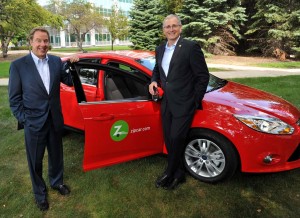
Ford Chairman Bill Ford, shown here with Zipcar Chairman Scott Griffith. A growing number of households are relying on services like Zipcar rather than owning a vehicle.
Whether by choice or through financial reality, the number of American households without a car has doubled over the past two decades – and is now approaching 10%.
Significantly, the shift is affecting older Boomers as well as Millennials. The impact of this trend could be significant, especially when it comes to alternative forms of transportation such as car-sharing and mass transit, according to research by CNW Marketing.
“While the recession was in large part responsible for the latest spurt, the trend was already clear,” says CNW’s research chief Art Spinella, “A growing number of Americans felt they didn’t need or want a personal car.”
According to CNW data, the number of U.S. households without a car stood at a modest 5.7% in 1991. That figure stayed relatively stable through the early part of the new Millennium. But it has been increasing slowly since then, with a “rapid rise” beginning in 2007. By last year, the total number of carless households hit 9.3%.
The new research is in line with a separate study released last week by the U.S. Public Research Interest Group, or PIRG, which declared that, “the driving boom is over.” It noted a decline in the average household vehicle fleet, for one thing, and it found that Millennial motorists are both waiting longer to get a driver’s license than previous generations and clocking fewer miles on the road.
(The Driving Boom is Over, Says New Study. Click Here for more.)
But CNW’s research reveals that it’s not a phenomenon limited to just Millennials. The trend, says Spinella, is particular noticeable among “both youngest and oldest Americans.”
Where there’s resurgent urbanization among U.S. youth, he points out, a growing number of the elderly have moved to retirement communities where owning a car is no longer a requirement for getting services, for example. That’s a particularly notable shift for older Baby Boomers, a generation that defined America’s “on the road” car culture.
Without a sudden reversal, the trendline suggests that the number of carless households could reach 10% this year or soon afterwards. The question is whether the trend is going to continue indefinitely. As the recession clearly has been a factor in the shift, the economic recovery could lead at least some carless households to add wheels. But various studies suggest there are other factors at work and that there may never be a return to the high level of households with cars seen as recently as the 1990s.
The impact is likely to be felt in a number of ways.
While the U.S. new car market is recovering after its worst downturn since the Great Depression, few expect demand to reach the more than 17 million peak seen during past recoveries.
And as the number of No-Vehicle households rises, CNW forecasts the auto industry may be forced to shift more vehicles into fleets, whether commercial, government or even the fast-growing list of car-sharing services.
“While the full impact of these trends are years away, we can see the formation of a future that includes more car-sharing, increased use of public transportation and diminishing status of owning a new vehicle,” says Spinella. “Again, this is years away – perhaps a decade – but the shift is clearly taking root.”
